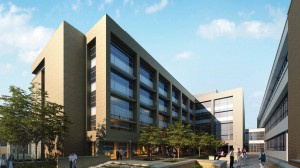
Artist rendering of the new School of Medicine building.
JACKSON, Miss. – Gov. Phil Bryant today helped celebrate a milestone in the construction of an emerging School of Medicine building during a “topping-out” ceremony at the University of Mississippi Medical Center.
Touting the economic and health care implications of a more spacious, state-of-the-art medical school, Bryant was among some 100 dignitaries and other attendees who watched as a construction crane hoisted a structural beam to the top of the building, signifying that it has reached its maximum height.
Along with medical students, as well as representatives of UMMC and the construction contractor, Bryant signed the beam before it was lifted, hewing to a construction tradition also meant to express appreciation to the building contractor and crew.
“This new medical school will have a $1.7 billion impact on our state by 2025 and will help create a support system of 19,000 – that’s 19,000 – jobs created,” Bryant said.
The 151,569-square-foot, five-story building will help advance Bryant’s goals of increasing the number of physicians working in Mississippi and boosting the state’s health care economy.
“Bringing one physician into a community has a $2 million impact,” he said. “It is the most effective economic development opportunity we have in the state of Mississippi.”
Dr. LouAnn Woodward, UMMC vice chancellor for health affairs and dean of the School of Medicine, thanked Bryant for “being a great champion” of the effort to build a new school and ultimately providing greater access to health care for more of the state’s residents, particularly those in rural areas.
“We are on a mission to train Mississippians to take care of Mississippians in this state,” Woodward said.
She also thanked her predecessor at UMMC, Dr. James Keeton, for his dedication to the construction project, as well as to the crew of Roy Anderson Corp. Contractors.
Construction on the building is on track for completion within 12 to 14 months, that is, the spring of 2017, Woodward said. Medical students will start classes in the new facility the following fall.
This new space will enable the School of Medicine to enlarge its incoming class size each year from 135 students to at least 165.
“Down the road, this is a great day for the state of Mississippi,” Woodward said.
Rising in the northeast area of the campus, facing Lakeland Drive, the new school will be similar in size to the UM law school in Oxford. Road work linked to the site has been completed.
UMMC has not had a new School of Medicine facility since the current one opened in 1955 as part of the Medical Center complex on State Street. Medical students have no dedicated medical school building, but use several: the Research Wing, University Rehabilitation Center, the VA Medical Center, Jackson Medical Mall and various other educational buildings and clinical sites on- and off-campus.
“We have classrooms and labs that are not just our space alone,” said Michelle Wheeler of Greenwood, a first-year medical student and one of the students who signed the construction beam.
“Having a new medical school gives me a feeling of gratitude that someone cares enough to give us our own building. We’re going to love it and cherish it.”
The economic impact of the practicing Mississippi physicians who trained at the School of Medicine is $6.3 billion annually. They support an estimated 60,395 jobs and generate about $706 million in annual federal and state tax revenue.
The new school will, among other things:
- Consolidate most classes and labs into one building, decreasing cross- and off-campus travel by students.
- Offer flexible, technology-rich classrooms with all-movable furnishings adaptable for lecture-style learning, teamwork sessions and other nontraditional learning methods.
- Provide a dedicated floor for simulation labs where medical and other health-professions students can learn techniques on software programs and computer-controlled interactive mannequins.
- Give students space for individual study, group study, congregating and social interaction.
- Provide large, tiered auditoriums with unobstructed views, room to swivel and work in groups, and wide desktops suitable for laptops, texts and notebooks.